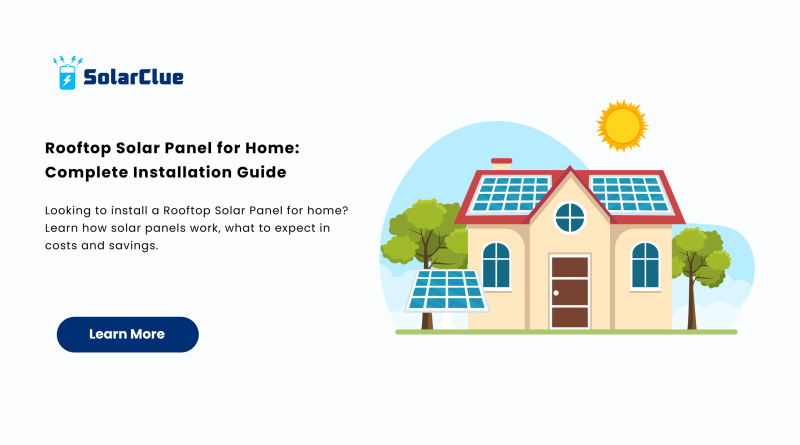Rooftop Solar Panel for Home: Complete Installation Guide
With rising electricity bills and growing environmental concerns, many Indian homeowners are turning to Rooftop Solar Panels for home as a smart and sustainable solution. Whether you’re motivated by reducing costs, becoming energy-independent, or simply embracing green living, installing a solar panel system on your rooftop is a long-term investment that pays back in many ways. In this blog, we will guide you through everything you need to know about installing a rooftop solar panel system, including how it works, types of solar systems, cost factors, government subsidies, and whether it’s really worth it.
Table of Contents
- 1 What Is a Rooftop Solar Panel System?
- 2 How Does a Solar Panel for Home Work?
- 3 Types of Rooftop Solar Power Systems
- 4 Benefits of Installing a Rooftop Solar Panel for Home
- 5 Cost of Rooftop Solar Panel for Home in India
- 6 Government Subsidy for Residential Solar Panels
- 7 Steps to Install a Solar Panel for Home
- 8 Common Mistakes to Avoid
- 9 Who Should Install a Rooftop Solar Panel?
- 10 How Much Can You Save?
- 11 Is It Really Worth It?
- 12 FAQs
What Is a Rooftop Solar Panel System?
A Rooftop Solar Panel for home refers to a solar power system installed on the roof of a residential building. It captures sunlight using photovoltaic (PV) cells and converts it into electricity for household use. These panels can be connected to the grid (on-grid), work independently (off-grid), or offer a hybrid setup.
How Does a Solar Panel for Home Work?
Here’s a simplified breakdown:
-
Sunlight hits the solar panels on your rooftop.
-
The solar energy is converted into direct current (DC).
-
An inverter then converts DC into alternating current (AC) – which is used to power your home.
-
Excess electricity is either stored in batteries or sent back to the grid (depending on the system setup).
By using a solar panel for home, you can generate your own electricity, reduce dependency on the power grid, and lower your monthly electricity bill.
Types of Rooftop Solar Power Systems
Choosing the right system is key to maximizing efficiency and cost savings.
1. On-Grid System
Connected to the main power grid. Net metering allows excess electricity to be credited to your account. Ideal for homes with consistent electricity supply.
2. Off-Grid System
Not connected to the grid. Relies on battery storage. Suitable for remote or rural areas with frequent power outages.
3. Hybrid System
Combines both grid connection and battery backup. Offers flexibility and uninterrupted power.

Benefits of Installing a Rooftop Solar Panel for Home
- Significant Savings: Reduce or eliminate your electricity bill.
- Government Incentives: Avail central and state subsidies of up to 40% on residential solar systems.
- Eco-Friendly: Switch to solar energy and reduce your carbon footprint.
- Increase Property Value: Homes with solar panel systems are more attractive to buyers.
- Low Maintenance: Once installed, solar panels require minimal upkeep.
Cost of Rooftop Solar Panel for Home in India
The cost depends on the size of the system, quality of equipment, and location. Here’s a rough estimate:
| System Size | Suitable For | Approximate Cost (₹) |
|---|---|---|
| 1 kW | 1 BHK home | ₹70,000 – ₹85,000 |
| 3 kW | 2-3 BHK home | ₹1.8L – ₹2.3L |
| 5 kW | Large homes | ₹3L – ₹3.8L |
These prices include panels, inverter, structure, wiring, and installation. With government subsidies, the overall investment becomes much more affordable.
Government Subsidy for Residential Solar Panels
To promote clean solar energy, the Indian government provides subsidies through the MNRE (Ministry of New and Renewable Energy):
Up to 40% for systems up to 3 kW
20% for systems between 3 kW and 10 kW
Process: Apply via the National Portal for Rooftop Solar or contact a registered vendor.
Steps to Install a Solar Panel for Home
-
Site Assessment: A technician inspects your rooftop space and energy needs.
-
System Design: Based on sunlight exposure, roof type, and power usage.
-
Quotation and Approval: Finalizing the cost and applying for subsidy if eligible.
-
Installation: Structure setup, panel mounting, inverter connection.
-
Inspection & Commissioning: Testing the system and activating net metering.
Common Mistakes to Avoid
- Choosing low-quality panels to cut costs.
- Ignoring the orientation and tilt angle of panels.
- Not considering future electricity consumption growth.
- Skipping annual maintenance or cleaning schedules.
Who Should Install a Rooftop Solar Panel?
This solution is ideal for:
Homeowners tired of increasing electricity bills.
Residents in high-sunlight areas like Rajasthan, Gujarat, Karnataka, and Telangana.
People seeking sustainable living options.
Households with unused terrace space.
How Much Can You Save?
A 3 kW solar panel for home can generate around 12-15 units per day. With proper usage and net metering, this can translate to monthly savings of ₹2,500 to ₹4,000, depending on your region and power tariff. Over 25 years, that’s over ₹10-12 lakhs in savings!
Is It Really Worth It?
Absolutely! A rooftop solar panel for home is not just an energy upgrade—it’s a lifestyle upgrade. It offers financial relief, energy independence, and a step toward sustainability. And thanks to falling prices and growing incentives, there’s never been a better time to go solar.
FAQs
Q1. How long does a solar panel last?
Most solar panels come with a 25-year performance warranty.
Q2. Can I run ACs or geysers on solar?
Yes, a well-sized solar power system can handle heavy appliances too.
Q3. What if there’s no sunlight for days?
Hybrid or off-grid systems come with batteries to store backup power.
Q4. Is rooftop solar safe for my building?
Yes, if installed properly by a certified professional.
Q5. What is net metering and how does it help?
Net metering allows you to send excess power to the grid and earn credits, reducing your electricity bills.
If you’re ready to make the smart switch and power your home with clean solar energy, visit solarclue.com or explore in-depth articles and guides at blog.solarclue.com – your rooftop might just be your smartest investment yet!




